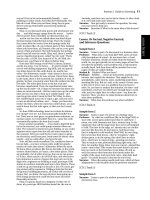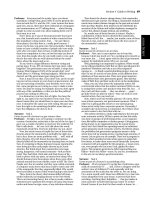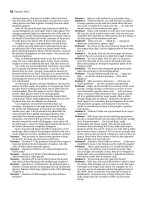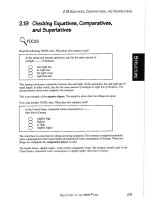General Principles for Approaches to the Facial Skeleton - part 9 docx
Bạn đang xem bản rút gọn của tài liệu. Xem và tải ngay bản đầy đủ của tài liệu tại đây (974.28 KB, 18 trang )
Figure 1 3 10-10 Sigmoid notch retractor. The curved flange at the end is inserted into the sigmoid notch,
retracting the masseter muscle.
149
Figure 1 4 10-11 Exposure of the posterior ramus. The sigmoid notch retractor is placed into the sigmoid
notch, elevating the masseter, parotid, and superficial tissues.
150
Figure 10-12 Anatomic dissection showing exposure of the posterior ramus with retraction of the superior
division of VII by the channel retractor (*). + = marginal mandibular branch VII; RV = retromandibular vein
Step 6. Closure
The masseter and medial pterygoid muscles are sutures together with interrupt resorbable sutures. It
may be difficult to pass the suture needle through the medial pterygoid muscle because it is very
thin at the inferior and posterior borders of the mandible. To facilitate closure, the edge of the
medial pterygoid muscle can be stripped for easier needle passage.
Closure of the parotid capsule/SMAS and platysma layer is important to avoid salivary
fistula. A running, slowly resorbing horizontal mattress suture is used to tightly close the parotid
capsule, SMAS, and platysma muscle in one watertight layer. Placement of subcutaneous sutures is
followed by skin closure.
151
ALTERNATIVE APPROACHES TO THE MANDIBULAR RAMUS
Added exposure of the mandibular ramus is frequently required. Combinations of approaches such
as the preauricular and the retromandibular offer increased exposure for some procedures, such as
those for temporomandibular ankylosis. If even greater exposure is required, one can connect these
two approaches using a modified Blair incision (Fig. 10-13). This incision is used frequently for
operations involving the parotid, but it can be useful for those involving the mandibular ramus.
Figure 1 5 10-13 Modified Blair incision. The preauricular and retromandibular
approaches are connected by an incision hidden in the lobular crease of the ear. The
anteroposterior position of the retromandibular portion of the approach may be
customized. In this illustration , the incision parallels the stenocleidomastiod muscle and
is more posterior than the retromandibular approach described previously.
152
153
11 Rhytidectomy Approach
he rhitidectomy or facelift approach to the mandibular ramus is a variant of the
retromandibular approach. The only difference is that cutaneous incision is placed in a more
hidden location, the same location as in facelift. The deeper dissection is the same as
described for the retromandibular approach.
The main advantage of the rhytidectomy approach to the ramus is the les conspicuous facial
scar. The disadvantage is the added time required for closure.
T
SURGICAL ANATOMY
Great Auricular Nerve
The only significant structure specific to this approach not mentioned for the retromandibular
approach is the great auricular nerve. This sensory nerve begins deep in the neck as spinal roots C2
and C3, which fuse on the scalene muscle to form the great auricular nerve. As the nerve becomes
more superficial, it emerges through the deep fascia of the neck at the middle of the posterior border
of the sternocleidomastoid muscle. It crosses the sternocleidomastoid muscle at a 45
o
angle toward
the angle of the mandible, covered only by the superficial musculoaponeurotic layer (SMAS) and
skin. The nerve lies behind the external jugular vein. The nerve then may split into two branches as
it courses superiorly toward the lobe of the ear (Fig. 11-1). Some branches pass through the parotid
gland and supply the skin of a part of the outer ear of a variably wide area in the region of the
mandibular angle.
TECHNIQUE
Step 1. Preparation and Draping
Pertinent landmarks useful during dissection should be exposed throughout the surgical procedure.
When the rhytidectomy approach to the mandible ramus/angle is used, the structures that should be
visible in the field include the corner of the eye, the corner of the mouth, and the lower lip
anteriorly; and the entire ear and descending hairline, as well as 2 to 3 cm of hair superior to the
posterior hairline, posteriorly. The temporal area must also be completely exposed. Inferiorly,
several centimeters of skin below the inferior border of the mandible are exposed to provide access
for undermining the skin. Shaving the sideburns and temporal hair is unnecessary, except from a
convenience standpoint.
154
Figure 11- 1 Anatomic dissection showing the relationship of the great auricular nerve (*) to the
sternocleidomastoid muscle (SCM) and ear.
Step 2. Marking the Incision and Vascoconstriction
The skin is marked before injection of a vasoconstrictor. The incision begins approximately 1,5 to 2
cm superior to the zygomatic arch just posterior to the anterior extent of the hairline (Fig. 11-2).
The incision then curves posteriorly and inferiorly, blending into a preauricular incision in the
natural crease anterior to the pinna (same position as in the preauricular approach to the
temporomandibular joint, see Chap. 12). The incision continues under the lobe of the ear and
approximately 3 mm onto the posterior surface of the auricle intead of in the mastoid-ear skin
crease. This modification prevents a noticeable scar that occurs during contractive healing of the
flap, pulling the scar into the neck. Instead, the incision is well hidden by the ear, it curves
posteriorly toward the hairline and then runs along the hairline, or just inside it, for a few
centimeters.
A vasoconstrictor is injected subcutaneously to aid hemostasis at the time of incision. One
should not inject local anesthetics deep to the platysma muscle because of the risk of rendering the
facial nerve branches nonconductive, making electrical testing impossible
155
Figure 11- 2 Incision through skin and subcutaneous tissue.
156
Step 3. Skin Incision and Dissection
The initial incision is carried through skin and subcutaneous tissue only (Fig. 11-2). A skin flap is
elevated through this incision using sharp and blunt dissection with Metzenbaum or rhitidectomy
scissors (Fig. 11-3). The flap should be widely undermined to create a subcutaneous pocket that
extends below the angle of the mandible and a few centimeters anterior to the posterior border of
the mandible. No significant anatomic structures are in this plane except for the great auricular
nerve, which should be deep to the subcutaneous dissection. Hemostasis is then achieved with
electrocoagulation of bleeding subdermal vessels.
Figure 11- 3 Underminig of the skin with Metzenbaum of facelift scissors.
157
Step 4. Retromandibular Approach
Once the skin has been retracted anteriorly and inferiorly, the soft tissue overlying the posterior half
of the mandibular ramus are visible (Fig. 11-4). From this point on, the dissection proceeds exactly
as described for the retromandibular approach (see Chap. 10). The bony access is the same in both
approaches (Fig. 11-5).
Figure 11- 4 The amount of subcutaneous dissection necessary for exposure of the posterior mandible.
158
Figure 11- 5 The posterior mandible exposed through the rhytidectomy approach. The retractor is placed
into the sigmoid notch, retracting the masseter, parotid, and superior branches of VII.
159
Step 5. Closure
Deep closure is performed as described for the retromandibular approach. After the parotid
capsule/SMAS/platysma layer is closed, a 1/8- or 3/32-in. round vacuum drain is placed into the
subcutaneous pocket to prevent hematoma formation. The drain can exit the posterior portion of the
incision or a separate stab in the posterior part of the neck. A two-layer skin closure is performed
(Fig. 11-6).
Figure 11- 6 Closure and subcutaneous drain placement.
160
S E C T I O N
VI
APPROACHES TO THE
TEMPOROMANDIBULAR
JOINT
The temporomandibular joint (TMJ) and its components frequently require exposure for a
myriad of procedures. Internal derangements of the TMJ, arthritis, trauma, developmental
disorders, and neoplasia may all affect the TMJ and/or the skeletal and soft tissue components.
Several approaches to the TMJ have been proposed and used clinically. The standard and most
basic, however, is the preauricular approach, which is described in detail in this section.
Variation are briefly mentioned.
12 Preauricular Approach
Although the TMJ itself is relatively small, many important anatomic structures are nearby. This
region contains the parotid gland, superficial temporal vessels, and facial and auriculotemporal
nerves.
Parotid Gland
The parotid gland lies below the zygomatic arch, below and in front of the external acoustic
meatus, on the masseter muscle, and behind the ramus of the mandible. The superficial pole of
the parotid lies directly on the TMJ capsule. The parotid gland itself is enclosed within a capsule
derived from the superficial layer of the deep cervical fascia, frequently called
parotideomasseteric fascia.
Superficial Temporal Vessels
The superficial temporal vessels emerge from the superior aspect of the parotid gland and
accompany the auriculotemporal nerve (Fig. 12-1). The superficial temporal artery arises in the
parotid gland by bifurcation of the external carotid artery (the other terminal artery is the
internal maxillary). As it crosses superficial to the zygomatic arch, a temporal branch is given
off just over the arch. This vessel is a common source of bleeding. The superficial temporal
artery divides into the frontal and parietal branches a few centimeters above the arch. The
superficial temporal vein lies superficial and usually posterior to the artery. The
auriculotemporal nerve accompanies, and is posterior to, the superficial temporal artery.
163
Figure 12 1 Anatomic dissection showing structures of importance : AE = articular eminence of the
temporal bone; ATN = auriculotemporal nerves; C = condyle; EAC = external auditory canal (outer ear
removed); STA = superficial temporal artery; TB VII = temporal branches of the facial nerve
Auriculotemporal Nerve
The auriculotemporal nerve supplies sensation to parts of the auricle, the external auditory
meatus, the tympanic membrane, and the skin in the temporal area. It courses from the medial
side of the posterior neck of the condyle and turns superiorly, running over the zygomatic root
of the temporal bone (see Fig. 12-1). Just anterior to the auricle, the nerve divides into its
terminal branches in the skin of the temporal area. Preauricular exposure of the TMJ area almost
invariably injures this nerve. Damage is minimized by incision and dissection in close
apposition to the cartilaginous portion of the external auditory meatus, realizing that this
structure runs somewhat anteriorly as it courses from lateral to medial. Temporal extension of
the skin incision should be located posteriorly so that the main distribution of the nerve is
dissected and retracted forward within the flap. Fortunately, patients rarely complain about
sensory disturbances that result from damage to this nerve.
164
Facial Nerve
Shortly after the facial nerve exits the skull through the stylomastoid foramen, it enters the
parotid gland. At this point, the nerve usually divides into two main trunks (temporofacial and
cervicofacial), the branches of which variably anastomose to form a parotid plexus. The division
of the facial nerve is located between 1.5 and 2,8 cm below the lowest concavity of the bony
external auditory canal.
Terminal branches of the facial nerve emerge from the parotid gland and radiate
anteriorly (see Fig. 12-1). The terminal branches are commonly classified as temporal,
zygomatic, buccal, marginal mandibular, and cervical. The location of the temporal branches is
of particular concern during TMJ surgery, as these are the branches most likely to be damaged.
As the temporal nerve branches (frequently two) cross the lateral surface of the zygomatic arch,
they course along the undersurface of the temporoparietal fascia (see Fig. 6-5). The temporal
branch crosses the zygomatic arch at varying locations from one individual to the next, and
range anywhere from 8 to 35 mm (20 mm average) anterior to the external auditory canal (Fig.
12-2) (1). Therefore, protection of the temporal branches of the facial nerve can be achieved by
routinely incising through the superficial layer of temporalis fascia and periosteum of the
zygomatic arch not more than 0,8 cm in front of the anterior border of the external auditory
canal.
Figure 12 2 Major branches of the facial nerve. The distance from the anterior
concavity of the external auditory canal to the crossing of the zygomatic arch by
the temporal branch varies from 8 to 35 mm.
165
Temporomandibular Joint
The TMJ capsule defines the anatomic and functional boundaries of the TMJ. The thin, loose
fibrous capsule surrounds the articular surface of the condyle and blends with the periosteum of
the mandibular neck. On the temporal bone, the articular capsule completely surrounds the
articular surfaces of the eminence and fossa (Fig. 12-3). Attachments of the capsule adhere
firmly to bone. Anteriorly, the capsule is attached in front of the crest of the articular eminence;
laterally, it adheres to the edge of the eminence and fossa; and posteriorly, it extends medially
along the anterior lip of the squamotympanic and petrotympanic fissure. The medial attachment
runs along the sphenosquamosal suture. The articular capsule is strongly reinforced laterally by
the temporomandibular (lateral) ligament, composed of a superficial fan-shaped layer of
obliquely oriented connective tissue fibers and a deeper, narrow band of fibers that run more
horizontally (Fig. 12-3). The ligament attaches broadly to the outer surface of the root of the
zygomatic arch and converges downward and backward to attach to the back of the condyle
below and behind its lateral pole.
The articular disk is a firm but flexible structure with a biconcave shape (Fig. 12-4). The
disk is usually divided into three regions: posterior band, intermediate zone, and anterior band.
The central intermediate zone is considerably thinner (1 mm) than the posterior (3 mm) and
anterior (2 mm) bands. The upper surface of the disk adapts to the contours of the fossa and
eminence of the temporal bone, and the lower surface of the disk adapts to the contour of the
mandibular condyle.
Posteriorly, the disk and the loosely organized posterior attachment tissues (bilaminar
zone, retrodiscal pad) are contiguous. The retrodiscal tissues are attached to the tympanic plate
of the temporal bone posterosuperiorly and to the neck of the condyle posteroinferiorly.
Anteriorly, the disk and the capsule and fascia of the superior head of the lateral pterygoid
muscle are contiguous. The superior head of the lateral pterygoid muscle may have some fibers
inserting directly into the disk anteromedially.
The articular disk of the TMJ is a hypovascular intra-articular structure that separates
the condylar head from the glenoid fossa. It is firmly attached to the condyle at its lateral pole; it
is not directly attached to the temporal bone. The articular disk and its posterior attachment
tissues merge with the capsule around their periphery. The disk and its attachment divide the
Figure 12 3 The temporomandibular joint (TMJ) capsule and
lateral ligament. The lateral ligament has both oblique and
horizontal components.
166
Figure 12 4 Sagital section through the temporomandibular joint (TMJ).
The articular disk (D) is white because of its avascularity. The bilaminar
zone (BZ) is red as a result of its lush blood supply . The lateral pterygoid
muscle (LPtM) may have some fibers that attach to the anterior portion of
the disk
joint space into separate superior and inferior spaces. In the sagital plane, the upper joint space
is contiguous with the glenoid fossa and the articular eminence. The upper joint space always
extends farther anteriorly than the lower joint space. The lower joint space is contiguous with
the condyle and extends only slightly anterior to the condyle along the superior aspect of the
superior head of the lateral pterygoid muscle. In the frontal plane, the upper joint space overlaps
the lower joint space. Therefore, entrance through the lateral capsule starts in the superior
compartment.
Layers of the Temporomandibular Region
The temporoparietal fascia is the most superficial fascia layer beneath the subcutaneous fat
(Fig. 12-5). This fascia is the lateral extension of the galea and is continuous with the superficial
musculoaponeurotic layer (SMAS). It is frequently called the superficial temporal fascia or the
suprazygomatic SMAS. It is easy to miss this layer completely when incising the skin, because
it is just beneath the surface. The blood vessels of the scalp, such as the superficial temporal
vessels, run along its superficial aspect closely related to the subcutaneous fat. On the other
hand, the motor nerves, such as the temporal branch of the facial nerve, run on the deep surface
of the temporoparietal fascia.
The subgaleal fascia in the temporoparietal region is well developed and can be
dissected as a discrete fascial layer if desired, but it is usually used only as a cleavage plane in
the standard Preauricular approach.
The temporalis fascia is the fascia of the temporalis muscle. This thick fascia arises
from the superior temporal line and fuses with the pericranium. The temporalis muscle arises
from the deep surface of the temporal fascia and the whole of the temporal fossa. Inferiorly, at
the level of the superior orbital rim, the temporal fascia splints into medial border of the
zygomatic arch. A small quantity of fat between the two layers is sometimes called the
superficial temporal fat pad. A large vein frequently runs just deep to the superficial layer of
temporalis fascia.
167









